
|
|
Click here for the site directory. |
|---|---|
| Please consider linking to this site! | Click here to email us. |
Sponsored link/s:
Sponsored link/s:

These are, without doubt, the most-discussed home-garden vegetable of all. We suspect that one big reason for the tidal wave of interest in tomatoes is the virtually total disappearance from grocery stores of edible tomatoes. We once lived in a town where a tomato-processing plant was the main industry. It was almost literally nauseating to see truck after truck full of deep-green tomatoes pull up to the plant (or should we say “factory”?) and then truck after truck pull away loaded up with bright red tomatoes made that color solely by an application of that ever-popular gas, ethylene. Mmmmm, love them rock-hard, tasteless, unripened ’maters!
But whether the interest wave is a response to a lack or whether people just love tomatoes, period, the result is the same: lots and lots—too much, almost—of information on varieties. One can even find taste-test results (many) and long threads on discussion boards with lengthy opinions on various types. But slogging through all that brings one point into sharp clarity: there are at least two very different schools of thought on tomato taste.
It is extraordinarily common, these days, to see a cherry tomato variety named Sungold (there are both open-pollinated and hybrid versions that, by report, taste much alike) called “the greatest tomato in the world of all time!” and similar modest cognomens. “My wife/daughter/husband/mom/dad won’t eat any other kind of tomato!” is another common claim. But, if we sift the literature more carefully, we discover the hard-core fact beneath all those panegyrics: the bleeding thing is terrifically sweet. We will repeat here something we say in our discussion of corn types:
Americans are literally spoon-fed sugar from—again literally—the crib onward. Some noted chef once remarked that each country’s cooking has its characteristic taste: in France, butter; in Italy, tomatoes; and in America, tin. He would have been more nearly accurate to say “in America, sugar.” There is sugar in virtually everything Americans are sold at the grocery store. So, it is hardly surprising that with that artificial, force-fed taste so widespread there is now lots of sugar in even home-garden vegetables…
With tomatoes as with corn, there remains a core—apparently smaller with every passing year—of fanciers who want the taste of the vegetable as opposed to that of sugar. What is the point of putting out a saucerful of sugar, dribbling some red food coloring over it, and calling it a tomato? (Or use yellow and call it corn, and so on.)
Any form of store-bought prepared tomato product—sauce, paste, and so on, or even pizzas—is today nearly useless to those already weaned from baby tastes. It’s all sugar, sugar, sugar. So if you have sympathy with our point of view, then beware most of those anecdotal reports and “taste-test” results. Only when you can read a sober and detailed discussion of the flavor qualities of a given cultivar, and find “tomato” used more often than “sweet” in the flavor description, can you assign any shred of credibility to the report. You have been warned!
Our own interest in tomatoes is most sharply focussed on tomatoes for cooking—for sauces (which can be frozen), for stews, and the like—with a secondary focus on tomatoes for sandwiches and like uses and a tertiary focus on tomatoes for salads. That is mostly because fresh uses of tomatoes—sandwiches, salads, and the like—are only possible during the harvest season, whereas cooked-up sauces (and paste) can be frozen for year-round use.
We also like to grow a couple of cherry-tomato types indoors in containers, so as to have at least some fresh-tomato flavor available year-round. Those go into salads, or directly into our mouths. With care, an indoor tomato plant can be perennial (in their native high-warmth environments, thatSs what they are).
Tomatoes grown for cooking use have traditionally been what are commonly called “plum” or “paste” (or sometimes, from one well-known cultivar, “Roma”) tomatoes. That sort is well suited because it is very dense, with little excess water, and has few seeds and little gel, and so quickly (or relatively quickly, anyway) cooks down to a thick sauce or paste. But, as Dr.Carolyn Male—one of the world’s leading tomato experts—points out in her justly famous book 100 Heirloom Tomatoes for the American Garden, the sad truth is that most paste tomatoes don’t have much flavor; moreover, she goes on, there are many “ordinary” tomatoes that are dense and suited for cooking. And if a given variety isn’t unusually dense, just—duh—cook it down a little longer.
But, though Dr Male says gardeners in USDA Zones 4, 5, and 6 “have the best selection of heirlooms that will grow well,” our own experience—granted that we are in a “frost pocket”—is that we struggle to vine-ripen tomatoes (and peppers). We, at least—and we urge this advice on all in our region till they can prove to themselves that they are better situated—need to concentrate on those suitably early good cultivars we can identify. Note that “suitably”: we don’t necessarily need the very earliest types, just those that don’t stretch our season’s envelope. Note also that qualifying “good”: there are some almost absurdly early tomato types, but earlies notoriously lack the flavor quality that is the main reason we grow our own. The number of good early types is rather small.
And this is as good a place as any to speak of “heirloom” tomatoes: what they are and why we do and you should want them. “Heirlooms” are pretty much what the name suggests; it’s a type that has been around a good long while and has stood the test of time. Exact definitions vary from source to source; Dr Male aptly summarizes the types people tend to call “heirlooms”:
commercial heirlooms: varieties introduced by commercial seedsmen prior to 1940.
family heirlooms: varieties selectively bred through the generations by families or small communities of amateur growers.
created heirlooms: varieties created by careful crosses between two known heirlooms or one heirloom and a hybrid, to blend particular wanted qualities; this type requires growing out for stability for a good number of years before it becomes an heirloom in its own right.
mystery heirlooms: generally the result of accidental, undesigned crosses in nature, but recognized and grown out to stabilize the type as with “created” hybrids; but often the exact parents remain unknown.
We need to say right here that discussing particular varieties, even within the constraints imposed by the words “early” and “good” (most especially “good”) is very much like discussing religion: one gets much heat but little light.
We’re about to give a list of a few types, but let us emphasize that while they are far from arbitrary, they are not necessarily the runaway winners—there are (as we well know from tedious hours) many other types that likely meet those twin criteria. Our choices were determined in some part by our own experiences, in some part by reading what experienced home tomato growers have said, and even in part by what types are available as transplants from trusted sources.
(Many of the the types below have days-to-maturity values whose high end is 80 days, which would be a bit of a risk in our climate; but their low ends are all around 70, and though our summers are short, they are fairly hot, so we expect the lower part of the DTM range is the more likely.)
So, with all that understood, the envelope please:
Burbank Slicing - a productive red slicing tomato, 3" to 4"; sufficient acidity for canning. Heirloom. DTM 75.
Bush Beefsteak - highly productive, satisfactory taste; tall plants. Heirloom. DTM 62 - 80.
Italian Heirloom - vigorous, productive growth, large oxheart-shaped meaty fruits with few seeds, c. 1# to 2#; taste “A+” as one reviewer put it. Heirloom (obviously). DTM 70 to 80.
Chocolate Stripes - large, bi-color fruit; reports on productivity and taste vary a bit, but are generally positive for both. Heirloom. Indeterminate.
Pruden’s Purple - large (10 ounces to a pound), meaty purple (or dark pink) beefsteak “potato leaf” type; said to be one of the best-flavored of all tomatoes. Heirloom. DTM 69 to 80.
Pink Berkeley Tie Dye - large ’maters with excellent taste; slow to get going, but then comes on. (Bred by Brad Gates, “the tomato guy”, and first offered in 2008.) DTM 69 - 80.
Blush - excellent flavor; elongated shape, can readily be sliced for salads or sandwiches (or pizza topping); thick skins; long holding. Indeterminate. DTM 60 - 70.
Orange Paruche [hybrid] - tangy taste said to be even better than the famed Sungold; very productive. “Semi-determinate”. DTM 55 - 68.
A tomato gallery:


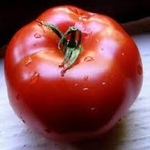
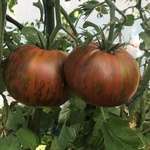
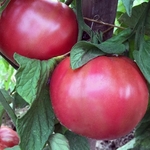
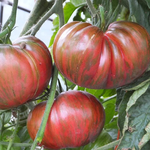
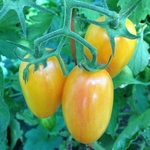
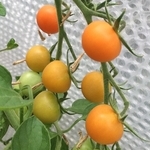
We expect that after the results are in for this season, we will—depending on results—reduce the number of types we grow to just a few. Many gardeners like to grow quite a number of types, but we prefer to just stick to what has worked well for us (with maybe one new type a season). “So Many Tomatoes, So Little Time…”
Do not plant tomatoes or any of their garden cousins—potatoes, peppers, eggplants, tomatoes—in the same soil two years running, and a four-year rotation is much better, or you risk certain pests (eel worms, for example) becoming both severe and ineradicable.
The first thing you need to know about any tomato cultivar you are considering planting is whether it is a “determinate” or an “indeterminate” type: determinate types—mostly (but not wholly) modern developments for commercial growers—form bushes that grow to a certain height and stop, and bring all their fruit ripe at about the same time; indeterminate types will grow and grow, sometimes to astounding lengths or heights, and will bear fruit all season long—they can be picked and picked. Most—but not all—heirloom tomatoes are indeterminate. Indeterminate types must be provided with large, sturdy supports to grow on: most people, including us, seem to favor circular cages made from heavy-duty large-mesh wire (some use “range fence” and some use the sort of reinforcing mesh normally placed in concrete—the latter has the advantage that one can make tall cages, five or six feet, without splicing sections). What makes a good cage diameter is debated, but Dr. Male suggests 22 to 24 inches, which works well for us. Be sure the cage mesh is large, say 6 inches, so you can easily reach through it to pick.
Around here, about the earliest date for setting out tomato transplants would be June 1st. But whatever your inclinations, wait for the soil temperature to reliably be 65° or more. Since we want our seedlings to be 6 to 8 weeks old, we should start them somewhere from April 24th to May 8th.
(With tomatoes, as with several types of plant, we prefer to use bought transplants; we’re fairly black-thumbed about starting seedlings successfully.)
Sow your seed indoors 6 to 8 weeks before your expected transplanting date, which around here—reckoning back from June 1st, would be early April. Use a good starting mix, not hardware-store “potting mix”: you want a soil-free medium, to be sure there are no fungal problems (Dr. Male cites “Jiffy Mix” and “Pro-Mix” as representative examples of the sort of thing wanted, and many mail-order garden-supply houses have proprietary types). Sow seeds in well-moistened mix; if you’re using a seed tray (the recommended approach, mix the water in before or while setting the mix into the pan. Set the seeds about 1/8 inch deep, and afterward gently tamp the mix down so the seeds are well placed in the mix. (If you are using a pan or something like, sow the seeds in rows about an inch apart, and at about 1/8 of an inch apart within the rows.)
If at all possible, provide heat beneath the seed tray, because the optimum temperature for tomato-seed germination is 86° F. If you haven’t got heating pads or something of the like, meant for the purpose, set your trays or whatevers over something warm, like a light or a refrigerator top—but it’s best to do the job right with things meant for the purpose.
Be sure the mix remains moist, but not soggy; a true mister is a handy thing for this. At the first signs of seedling emergence, put the tomatoes where they will receive plenty of light; the best technique is to place them directly under purpose-made fluorescent fixtures fitted with fluorescent tubes intended for plant growing (be sure to keep the lights not over a couple of inches above the plants’s tops); give them a good 16 hours a day of light. You can stop providing direct heat when seedlings emerge, but continue to keep them in a warm area.
When the second, or “true” set of leaves arrives (at emergence, there is a small set of “false” leaves that are not really leaves—the true ones show up when the plant is perhaps a couple of inches tall) and show two true leaves, it’s time to transplant—not outdoors yet, but into roomier quarters, such as 2-inch cells. Wait a couple of weeks, then apply a mild, dilute liquid fertilizer (too strong and it’ll almost literally “burn” your tender seedlings). If at any time you see any plants whose lower leaves are deveoping a distinctly brown edge, just pull off those leaves.
When your seedlings reach perhaps 9 inches to a foot in height, it’s time for them to go outdoors—exactly when being in good part dependent on the weather. “Going outdoors” doesn’t mean being transplanted yet, it means being hardened off—gradually acclimated to being outdoors. Set your trays outside in a shaded area for a few days (bringing them in at night), then move them to a partly sunny and eventually, over time, a full-sun area. Take a week or so for this process, and during that time, reduce their water supply; but about half a day to a day before the actual transplanting, give them a good dose of water. Also, if you see any blossoms forming at this time, remove them: it’s too early for fruiting.
The outdoors tomato bed should be prepared by deep digging, addition of organic material, and—as tests may show necessary—amendment with organic fertilizers. Tomatoes do best in a rich, loamy soil, though they’re reasonably tolerant. A standard garden-soil pH of 6.5 to 6.8 works fine, but they can do well enough in anything from 6.0 to 7.0. It is wise to use plastic mulch, and to set that mulch out a couple of weeks before transplant time to get the soil warmed. Plastic mulch also suggests drip irrigation, which is always a good thing; and row cover is advantageous as well in our climate.
Transplanting out can be done in several ways. Some simply plant in the usual manner; with tomatoes, that means setting them deep, as deep as possible, so that the lowest leaves are just barely above the soil surface. Another technique is trenching: make a shallow trench, say 4 to 6 inches deep, then lay the seedling (which is, recall, 9 to 12 inches tall) on its side in the trench, gently bending the stem so that only the plant’s top is above the soil surface (there are some illustrative photos on one of the sites linked below, well down that page). The virtue of this technique is that tomatoes will send down roots from any part of their stem that is in contact with soil, so this way one gets a lot of root, with much of it near the surface, where warmth and water access are better. But (there’s always a “but”), on the other hand, the root system isn’t as deep as with conventional planting. Dr. Male’s recommendation is to trench only for those seedlings that look spindly or “leggy” and are scarcely able to stand upright on their own; the good doctor grows an immense number of tomato plants annually, but we who grow less than immense numbers can afford to overplant and be picky by culling leggy seedlings at transplant time. Still, both methods bear consideration. As you see, peat pots are not felt by experts to be the best approach; but if you’re using them, be sure to bury their rims a good inch below the soil level, lest they wick out moisture from the soil to the air.
Keep your tomatoes regulary and perhaps above all evenly watered: an irregular water supply is at the bottom of many of the common problems seen in garden tomatoes.
Warmth-preserving devices such as the well-known “Wall o’Water” get a mixed reception. Some feel that tomato plants requiring WoWs have just plain been set out too early and will end up not being as productive over the season as a whole as plants grown well as indoor seedlings and set out at the right time. We concur with that sentiment, but also realize—from exceedingly bitter experience—that killing freezes can occur around here even well into June; we thus feel that WoWs have a place in tomato growing, and that place is as insurance for the first week or two for healthy transplants set out at the right time. When the first week or two of June have gone by, then remove the WoWs and put the cages in place. (Some gardeners use a variant technique: they set their cages in place at once, but wrap the cages with transparent or translucent plastic sheeting: that makes a sort of “mini-greenhouse”, though it doesn’t quite duplicate the heat-retaining qualities of the water cells in WoWs, it’s cheaper and a deal simpler—WoWs are a colossal pain in the, ah, elbow to fill and to prop up.)
Do not over-fertilize, else your plants will send their energies into vegetative growth rather than fruit-setting. If you have prepared the soil well, that should suffice. If you like, you can add a little balanced, mild, liquid supplementation about two weeks after transplanting out, then again when you see fruit actually starting to set.
Though one can get arguments on the subject of pruning tomato plants, we’ll go with Dr. Male’s advice: don’t. Do, though, try to gently assist your plants to make best use of their cages by training vines as appropriate.
As tomatoes come ready, pick them. With indeterminate plants, the more you pick, the more you get—like that bunny, they just keep on going, and going, and going.
When the weather gets cold enough that you fear for the continued life of your tomato plants, go ahead and pick any green tomatoes remaining on the vine; those can be ripened indoors.
Besides any links presented above on this page, the following ought to be especially helpful.
Tatiana's TomatoBase - an amazingly complete tomato database: the place most tomato experts go to first for information on unfamiliar types. Tatiana Kouchnareva runs a variety-preservation farm (which maintains over 4,000 varieties of open-pollinated, non-GMO, vegetables—1,178 tomato types), and also sells seed to help support the operation (she is a Garden Watchdog Top-5 Tomato-Seed company). A must-visit for any tomato fancier.
Pruning Tomatoes - highly useful advice, well illustrated
Plants For a Future Database: Tomato - tons of data on the vegetable, and links to lots more
Rick Sommer’s Tomato Growing Tips - especially valuable because of the many illustrative photographs
The Internet Shrine to the Tomato [archived copy] - an amusing and informative little site; it’s now dead and gone, but its ghost lives on in The Wayback Machine
Tomatoes are of the wonderful Solanaceae (or nightshade) family, as are peppers, tomatoes, potatoes, and eggplants, among others. There are nine species in the Lycopersicon genus, but only one other than L. esculentum is edible: L. pimpinellifolium, which is the so-called “currant” tomatoes (pea-sized tomato-ey things having chiefly novelty value).
All non-“currant” tomatoes are L. esculentum, but there is this distinction: the “standard” tomato is L. esculentum esculentum, while the cherry-tomato types are classed L. esculentum cerasiforme--which is closer to the ancestral tomato type.
There is a decent tomato history on line; it dispels the nonsensicality of the commonly accepted myth that no Westerner ate tomatoes till some brave soul in the 19th century ate a bunch in a public display.
“The neighbor would plant whole tomatoes that were just starting to turn at the first frost. He put them 12 inches deep and he had mobs of plants come up in the early spring. With big long roots.”
Sponsored link/s:
Sponsored link/s:
If you find this site interesting or useful, please link to it on your site by cutting and pasting this HTML:
The <a href="https://growingtaste.com/"><b>Growing Taste</b></a> Vegetable-Gardening Site

|
Since you're growing your own vegetables and fruits, shouldn't you be cooking them in the best way possible?
Visit The Induction Site to find out what that best way is! |
|
If you like good-tasting food, perhaps you are interested in good-tasting wines as well?
Visit That Useful Wine Site for advice and recommendations for both novices and experts. |
|
|
This site is one of The Owlcroft Company family of web sites. Please click on the link (or the owl) to see a menu of our other diverse user-friendly, helpful sites. |
|
|
| All Owlcroft systems run on Ubuntu Linux and we heartily recommend it to everyone—click on the link for more information. | |||
Because we believe in inter-operability, we have taken the trouble to assure that
this web page is 100% compliant with the World Wide Web Consortium's
XHTML Protocol v1.0 (Transitional).
You can click on the logo below to test this page!
You loaded this page on
Thursday, 17 April 2025, at 20:47 EDT.
It was last modified on Sunday, 13 February 2022, at 03:39 EST.
All content copyright ©1999 - 2025 by The Owlcroft Company